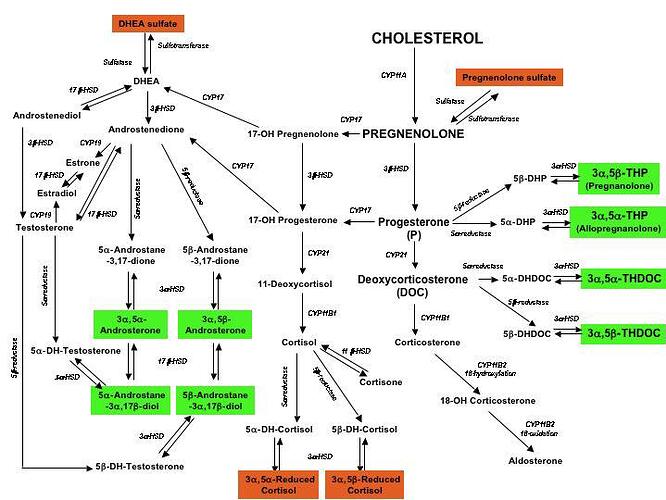Recent Developments in the Significance and Therapeutic Relevance of Neuroactive Steroids – Introduction to the Special Issue
2007
PDF: pubmedcentral.nih.gov/picren … obtype=pdf
ONLINE: pubmedcentral.nih.gov/articl … id=2047816
Selected bits:
“Neuroactive steroids are endogenous neuromodulators that can be synthesized de novo in the brain as well as adrenal glands, ovaries and testes.”
Neuroactive steroids modulate CNS development and repair following injury
"… The neurodevelopmental functions and mechanisms of action of four distinct neurosteroids – pregnenolone, progesterone, allopregnanolone and dehydroepiandrosterone are reviewed by Mellon (this issue).
Absence or reduced concentrations of neurosteroids during development and in adults may be associated with neurodevelopmental, psychiatric, or behavioral disorders.
Treatment with physiologic or pharmacologic concentrations of these compounds may also promote neurogenesis, neuronal survival, myelination, increased memory, and reduced neurotoxicity."
Neuroactive steroids modulate the HPA axis and the effects of stress
"The activation of the HPA axis in response to acute stress increases the release of corticotropin releasing factor from the hypothalamus, which stimulates the release of adrenocorticotropic hormone (ACTH) from the pituitary, which in turn, stimulates the adrenal cortex to release glucocorticoids, neuroactive steroid precursors and GABAergic neuroactive steroids.
Glucocorticoids, mainly cortisol in humans and non-human primates, and corticosterone in rodents, provide negative feedback upon the hypothalamus and pituitary. Likewise, GABAergic neuroactive steroids inhibit CRF production, release, ACTH release and subsequent corticosterone levels in rodents.
The ability of neuroactive steroids to reduce HPA axis activation may play an important role in returning the animal to homeostasis following stressful events. This physiological coping response appears to be critical for mental health since it is dysregulated in various mood disorders including depression, post-traumatic stress disorder and premenstrual dysphoric disorder.
“… While stress increases neurosteroid levels in the short term, animal models of chronic stress and depression show lower brain and plasma neurosteroid concentrations, and alterations in neurosteroid responses to acute stressors. Girdler and Klatzin (this issue) review the potential role of neuroactive steroids in depressive disorders. In humans, neurosteroid depletion is consistently documented in patients with current depression and may reflect their greater chronic stress.”
“Girdler et al suggest that that failure to mount an appropriate allopregnanolone response to stress may reflect the price of repeated biological adaptations to the increased life stress that is well documented in depressive disorders, and altered allopregnanolone stress responsivity may also contribute to the dysregulation seen in HPA-axis function in depression.”
“Neurosteroids play a crucial role in stress, alcohol dependence and withdrawal, and other physiological and pharmacological actions by potentiating or inhibiting neurotransmitter action.”
“The article by Biggio et al. (this issue) describes the effects of acute and chronic stress on peripheral and brain neurosteroid levels in rodents as well as GABAA receptor gene expression and function. Further, these authors describe the interactions between stress and ethanol exposure on brain steroidogenesis and the plasticity of GABAA receptors. These neurochemical and molecular mechanisms demonstrate the remarkable impact of neurosteroid actions through regulation of the HPA axis and GABAA receptors.”
Neuroactive steroids mediate ethanol actions
“Ethanol-induced elevations in neuroactive steroids reach physiologically relevant concentrations that are capable of enhancing GABAergic transmission.”
"Neuroactive steroids have been shown to modulate ethanol’s anticonvulsant effects (VanDoren et al., 2000), sedation (Khisti et al., 2003), impairment of spatial memory (Morrow et al., 2001; Matthews et al., 2002), anxiolytic-like (Hirani et al., 2005) and antidepressant-like (Hirani et al., 2002) actions. [Size=4]Each of these behavioral responses is prevented by pretreatment with the biosynthesis inhibitor finasteride [/size]and/or by prior adrenalectomy"
Summary and Conclusions
While many investigators have suggested the therapeutic relevance of neuroactive steroids in neuropsychiatric disease, there are currently no neuroactive steroids in clinical practice. However, ganaxolone (3α-hydroxy,3β-methyl,5α-pregnan-20-one) is under review by the FDA for childhood epilepsies.
The use of neuroactive steroid precursors, such as progesterone and pregnenolone may prove useful in some conditions, particularly traumatic brain injury, as suggested by Schumacher et al. (this issue). Remarkably, the first trials of progesterone in traumatic brain injury revealed no significant untoward effects.
Nonetheless, this issue remains a lingering concern for neuroactive steroid development. Since GABAergic neuractive steroids regulate GABAA receptor function and expression, the possibility of untoward effects during or following neurosteroid therapy must be explored.
Despite this concern, there is great optimism in the field for the usefulness of the inhibitory, anti-inflammatory, and myelin promoting targets of neuroactive steroids for CNS disease.
Diagram legend:
-
The inhibitory neuroactive steroids with potent GABAA receptor positive modulatory effects are highlighted in green,
-
The excitatory neuroactive steroids with weak GABAA receptor antagonist effects are highlighted in orange

